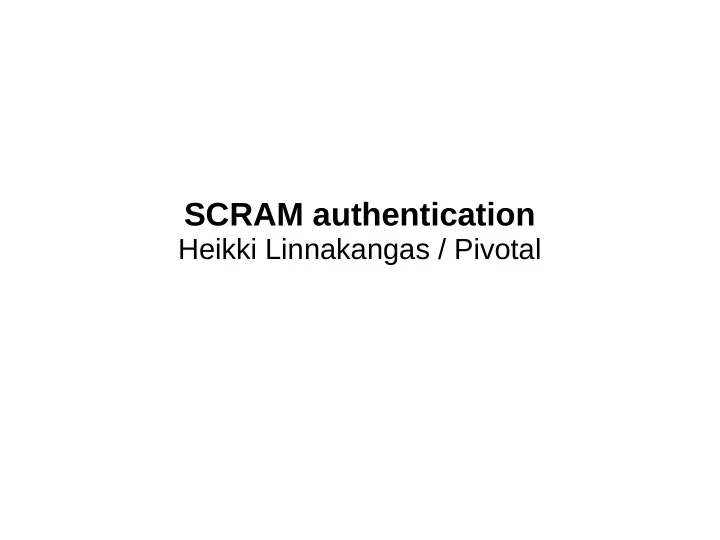

SCRAM authentication Heikki Linnakangas / Pivotal
pg_hba.conf # TYPE DATABASE USER ADDRESS METHOD # "local" is for Unix domain socket connections only local all all trust # Use plaintext authentication from localhost host all all 127.0.0.1 plain # Allow md5 authentication from example.com, with SSL hostssl all all .example.com md5 # Require SCRAM for everyone else host all all 0.0.0.0/0 scram-sha-256
PostgreSQL authentication methods ● Password-based: – password (plaintext) – crypt – md5 – scram-sha-256 – RADIUS / LDAP / PAM ● Others: – SSL certificate – kerberos
(Plain) Password authentication Server: Hey, what’s your password? Client: “Swordfjsh” Server: ok, cool
Plain password authentication ● Obviously weak – Password sniffing ● Ok over SSL – With sslmode=verify-full ● Used by RADIUS, LDAP, PAM, BSD authentication methods!
MD5 authentication Server: Here are 4 random bytes (salt). Please compute: md5(md5(password || username), salt) Client: 23dff85f7c38ee928f0c21ae710bba5d Server: Ok, cool
MD5 weaknesses md5( md5(password || username) , salt) ● Password guessing – My laptop can compute about 7 million MD5 hashes per second ● Replay – Only 4 billion unique 4-byte salts (birthday attack) ● Stolen hashes – You don’t need the original password to log in. The hash stored in pg_auth.rolpassword is enough.
Other MD5 issues ● Renaming a user invalidates the password – Because the hash includes the username ● db_user_namespace cannot be used – For same reason ● MD5 has a bad reputation
SCRAM to the rescue! ● S alted C hallenge R esponse A uthentication M echanism ● To be precise, PostgreSQL implements SCRAM-SHA-256 ● Defined by RFC 5802 and RFC 7677 ● Challenge-response like MD5 authentication
SCRAM Client: Hi! Here’s a random nonce: r=fyko+d2lbbFgONRv9qkxdawL Server: Hi! Here’s my random nonce, salt and iteration count: r=fyko+d2lbbFgONRv9qkxdawL3rfcNHYJY1ZVvWVs7j, s=QSXCR+Q6sek8bf92, i=4096 Client: Here’s my proof that I know the password: <ClientProof> Server: Ok, cool. And here’s my proof that I knew it too: <ServerProof>
SCRAM ● More resistant to dictionary attacks – The computation to guess password is much more resource intensive – Configurable iteration count ● Longer nonces defeat replay attacks ● The verifiers stored in pg_authid.rolpassword don’t allow impersonating the user
SCRAM-SHA-256 ● Relatively simple implementation – < 1000 lines of code in libpq ● Relies only on SHA-256 hash function
Password verifiers set password_encryption=' md5 '; create user md5_user password 'foo'; set password_encryption=' scram-sha-256 '; create user scram_user password 'foo';
Password verifiers SCRAM-SHA-256$<salt>:<iteration count>$<hashes> postgres=# select rolname, rolpassword from pg_authid rolname | rolpassword ------------+--------------------------------------------- md5_user | md591334fcda28129398a9cdb3f551e3cc8 scram_user | SCRAM-SHA- 256$4096:uZngi0eCu0IF6wbG$zMiBqWGTny5EEa1I+38fCT8OcuA0xbGA alZfHRh/g6g=:8KiMkegRYfcoEXk9+aLJwR1JhMbM4LyDxQE2arrEvRU= (2 rows)
Compatibility ● ‘md5’ in pg_hba.conf actually means “SCRAM- SHA-256 or MD5 authentication” ● ‘scram-sha-256’ means SCRAM-SHA-256 only ● Plaintext ‘password’ authentication works with either kind of hash
Simple Authentication and Security Layer (SASL) ● “The Simple Authentication and Security Layer (SASL) is a framework for providing authentication and data security services in connection-oriented protocols via replaceable mechanisms.” ● Decouples authentication from application protocol (like PostgreSQL’s FE/BE protocol) ● SCRAM is one SASL authentication mechanism
SASL ● Currently, PostgreSQL has a built-in SCRAM-SHA-256 implementation ● Would be straightforward to add more SASL authentication mechanisms ● Could use an external library to add support for more (e.g. Cyrus libsasl) ● Client can use a library that implements SASL and SCRAM-SHA-256 – Java has a very generic SASL implementation, but no built-in SCRAM-SHA-256 provider
PostgreSQL 10 ● SCRAM-SHA-256 ● Channel binding not supported ● Username is always passed as empty
Migrating 1.Upgrade all clients 2.Set password_encryption=’scram-sha-256’ in postgresql.conf 3.Change all user passwords
SCRAM is not encryption! ● SSL is still recommended – SCRAM is only authentication, not encryption!
Future, short-term ● Implement SCRAM-SHA-256 in all the drivers – JDBC, ODBC (uses libpq), Python, .Net, Ruby, … ● Add support to middleware – Pgbouncer, pgpool-II ● Add option to libpq to require SCRAM ● Implement channel binding
Channel binding ● “binds” the SSL session to the authentication exchange ● Defeats man-in-the-middle attacks ● Makes it unnecessary to have CA certificate in the client
Channel binding ● Not implemented yet ● Michael Paquier created a patch for PostgreSQL 11
Future, long-term ● Allow storing SCRAM verifier in LDAP ● Delegation for middleware ● Zero-knowledge proof – SRP
Questions?
Recommend
More recommend